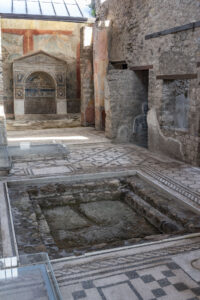
Pompeii: Antiquity’s Ghost Town
Most of us probably first heard about the ancient Roman city of Pompeii in school. You remember, the city buried in an eruption of Mt. Vesuvius in the first century AD. And, also like most of us, that’s about all you remember. As a kid reared in the fire and brimstone of working class Catholicism, I recall thinking this scenario had the fingerprints of that angry, punitive God of the Old Testament and I wondered what these people had done to piss him off.

Streets of Pompeii
Many years later I finally got some clarity when I spent an afternoon walking Pompeii’s streets. The city sits in Italy’s Campania region just south of Naples and it’s huge—over 170 acres. What made it particularly mind-boggling for me is that I was exploring an actual Roman city that wasn’t subjected to a couple millennia’s worth of plunder, vandalism, and entropy. For almost 2000 years, Pompeii lay buried beneath 13-20 feet of volcanic ash and pumice spewed by Mt. Vesuvius, and in what’s surely one of history’s great tragic ironies, that spared Pompeii the plunder and neglect that befell the majority of antiquity’s treasures. That is certainly a BIG deal.

Affluent home, Pompeii
Here’s an observation wrung from years of travel: It’s hard to avoid thinking about history when it’s all around you. Think Europe with its preserved medieval cities, its ancient ruins and monuments from antiquity. Americans aren’t surrounded by that kind of history the same way Europeans are. Which leads to another observation: the American educational system often treats history as some dry abstraction, full of dates and names, distant events in distant lands, with little or no apparent connection to life as lived in the here and now. We present history as if it happened to some other race of beings, failing to make the connection that those people were earlier versions of us.
History as taught in American schools puts the ‘human’ at a remove in human events, rarely, if ever, exploring the very human lives and concerns of those who lived it. So we end up with generations of citizens who ‘don’t know much about ‘his-tor-eee’, as Sam Cooke sang. They miss out on the insights history affords into our own age, all the patterns and cycles of human behavior and hubris that can help explain how we got here. Someone once said that history doesn’t necessarily repeat itself, but it echoes. That seems about right to me—and, trenchant.

Water spout, Pompeii
Anyway, Pompeii. Hints of a buried city had been discovered here in the late 16th century, but it wasn’t until the middle of the 18th century that excavation began in earnest and has continued for the last 200 years. As you can imagine, exposing this long buried ancient city has not been without consequence. Summer’s heat and winter’s chill, the rain and wind along with human mismanagement, have all caused serious damage to Pompeii’s structures. As a result, the focus today has shifted from further excavation to preservation of what’s already been discovered.
Two locations in particular stayed with me because they vividly revealed something of the life that was lived in Pompeii. First was the ‘Lupanar,’ which in Latin means, ‘wolf den’. The term is a revealing glimpse of Roman sensibilities as lupanar had nothing to do with Canus lupus. Romans called brothels by this name because a prostitute was a ‘lupa’ or ‘she-wolf’.
The Lupanar in Pompeii is actually the largest of ten brothels discovered in the city. It is a two-story structure with ten rooms, which were mostly brick platforms and a mattress. Above the rooms are erotic paintings which must have given the Enlightenment- and Victorian-era excavators some seriously red cheeks.

Fresco in Lupanar, Pompeii
Another feature that’s not as quickly appreciated is the variety of graffiti on the Lupanar’s walls. Clients would often leave notes for others in what amounted to a sort of ‘dialogue’, while prostitutes etched their thoughts in racy language that might have been an early form of ‘merchandising’. A couple of examples:
Hic ego puellas multas futui (“Here I fucked many girls”)
And…
Felix bene futuis (“Lucky guy, you get a good fuck”)

Priapic house ornament, Pompeii
Romans were anything but prudish and sex was hardly hidden for the benefit of polite society. Indeed, the Romans often used the image of an erect penis on carved reliefs or sculpted amulets and even wind chimes as both adornment and a means of warding off the ‘evil eye.’ This ‘priapism’ had more to do with the vitality of natural forces, especially the drive to reproduce. More on this can be found here: https://en.wikipedia.org/wiki/Erotic_art_in_Pompeii_and_Herculaneum#Brothels